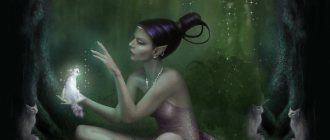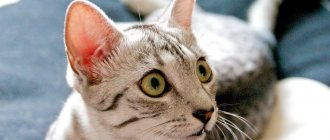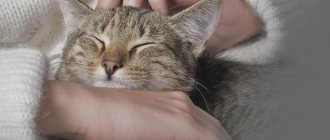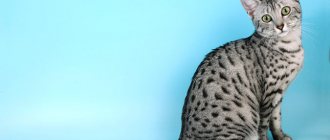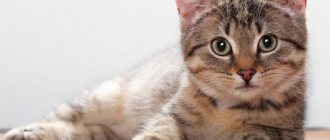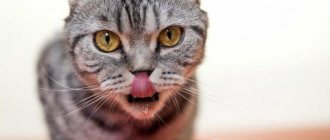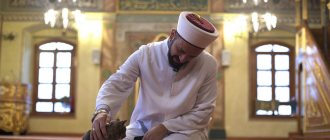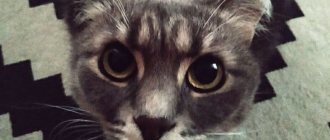Appearance of Bastet in mythology
In fact, there is very little information about the appearance of Bastet in Egyptian mythology.
It is reliably known that her father is the supreme god Ra, and her mother is the goddess Hathor. Essentially, Bastet is the daughter of the sun and the moon at the same time. Nevertheless, Buster was one of the most revered goddesses in ancient Egypt, and the popularity of her cult was not inferior to that of Amun-Ra. At least until the unification of Egypt and giving the cult of Amun-Ra the status of a state religion. Anton
Ask a Question
Question to the expert
Why are Bastet and Sekhmet considered the same character?
Before the unification of the country into a single whole, in lower Egypt people worshiped the daughter of Ra, named Bast, and in Upper Egypt they worshiped Sekhmet. However, after the unification of the country, the cult of worship merged together, and with it the images of the goddesses.
At the same time, opinions still differ even about who Bastet really was. She was believed to be the spiritual embodiment of the goddess Isis. At the same time, Bastet was responsible for many industries in Ancient Egypt. She was the goddess of joy, fun and love, the goddess of fertility. However, she was especially revered by women, because Bastet was also the goddess of the hearth, female beauty and the goddess of childbirth.
However, historians agree that Bastet gained particular popularity due to the fact that she was the goddess of cats. Perhaps no one needs to be reminded of how sacred cats were in ancient Egypt. Needless to say, if a driver who accidentally ran over a cat was stoned to death. And it was strictly forbidden to take these animals out of the country.
Cats were considered sacred animals in Egypt long before the popularization of the Bastet cult. Initially, cats were highly valued as fighters against snakes and mice. This may not be the main reason for the popularization of these animals, but it is certainly one of them.
It is not surprising that Bastet was depicted as a creature with the body of a man and the head of a cat. Moreover, she was depicted entirely in the body of a cat, but only in a sitting position. In a standing position, she remained half-human. It is noteworthy that Bast also had a second, more menacing appearance. The ancient Egyptians considered the lion a symbol of strength and protection. Therefore, it is not surprising that the second, formidable and warlike appearance of Bastet was Sekhmet - a creature with a female body and a lion’s head.
It is worth noting that Bast and Sekhmet were initially considered different characters. However, during the merger of Upper and Lower Egypt, the cult of the goddesses came together. And even before that, they were depicted in exactly the same way, with the same attributes and symbols of power, as a result of which the cult of Bastet united the goddesses into two opposing essences of one whole. In addition, during late Egypt, Bastet also merged with Isis.
Despite the fact that almost all sources say that Bast loved the color black (as evidenced by her love for black cats, as well as their demand at that time), the goddess preferred to dress in green robes. As always, in the images of that time, the goddess’s clothing was as open as possible.
Goddess Bastet - description, myths, interesting facts
Hello, dear readers! In ancient Egyptian mythology, the goddess Bastet was one of the supreme and highly revered deities. The heyday of her cult occurred in the 10th-8th centuries BC. This was directly related to the fact that during that period wild cats were actively tamed and domesticated. And the goddess is precisely connected with these animals.
In the city of Bubastis, which is now a small settlement near the Nile and is called Tell Basta, the largest temple was erected in honor of the ancient goddess. There was also a necropolis in which archaeologists discovered a large number of mummified cats.
The goddess Bastet appears in many myths and legends of Ancient Egypt. Museums contain figurines and other images from which it is easy to get an idea of what the goddess looked like. Statues in her honor were often made of bronze or copper and decorated with precious stones.
Description of the goddess
Over the long years of its existence, the mythology of Ancient Egypt has changed. Events in myths were not rewritten, but the gods themselves were transformed. Their appearance changed, some attributes were replaced by others, their pedigree was compiled anew. Bastet did not escape the same fate.
Scientists are still arguing whether it is correct to call the deity by the name Bastet (“crying”, “giving”). It is just as impossible to accurately decipher ancient Egyptian hieroglyphs as it is to determine how they are pronounced. Therefore, in a number of sources the goddess is called Bast. Both versions of the name are considered correct and valid. The spelling Ubastet is less common. Sometimes the celestial goddess is called Pusht or Pasht (Moon).
The deity was endowed with a light disposition. Legends say that Bastet loved fun, dancing and singing, and holidays. Therefore, celebrations in her honor were always bright and noisy. During the holidays, the Egyptians paid special attention to beer and wine. It was believed that the goddess loved intoxicating drinks.
Bast symbolized youth and beauty. This makes her similar to Hathor, who personifies beauty and love. People believed that if they asked Bastet to stop aging, the deity would help. Women in Ancient Egypt, performing a set of special physical exercises, focused all their thoughts on the image of the deity. In this way it was possible to summon Bast, who temporarily inhabited the body and bestowed grace and good health.
The name Bastet was associated with healing. She helped me recover. Doctors in Ancient Egypt painted a black cat at the patient’s bedside or on the door of his house. This ritual attracted the attention of the deity, who then healed the person. In addition, the goddess was associated with protection and security.
In the divine pantheon of Ancient Egypt there is a goddess named Sekhmet. Some sources describe her not as a separate character with her own history and responsibilities, but as the "dark", aggressive side of Bast. Sekhmet and Bastet are connected not only by these traits. Their appearances are similar in many ways.
Initially, Bastet was perceived by the Egyptians as a goddess in the form of a bloodthirsty and strong lioness. Gradually her appearance changed. Sekhmet is a woman with the head of a lion or lioness.
A description of the Egyptian goddess would not be complete without mentioning her family ties with other gods:
- the sun god named Ra - father Bast, mother Hathor, associated with the Moon; some legends say that initially Bastet was the wife of Ra and was among his faithful guards; according to other data, it follows that the parents of the goddess are Isis and Osiris;
- sister - Nut, she is the patron of Heaven;
- Bastet's brother's name is Khonsu, he is a healer god;
- Bes is a dwarf deity, “court jester”; he patronized the elderly and small children, bringing light and joy; sometimes he is called Bast's husband; in other legends, the goddess’s husband was Ptah, the god of creativity, art, and crafts;
- son – Mahes; the Egyptians depicted him with the body of a man and the head of a lion; he was endowed with a ferocious and cruel character; Mahes is a faithful servant and protector of Ra; he patronized the Egyptian pharaohs.
Because of her close connection with the Sun deity, Bast was called the All-Seeing One in Ancient Egypt. She has excellent intuition and is able to predict the future. One of the symbols of the deity was the star Sirius.
Appearance
Bastet has a female body with the head of a cat (or lioness), but she can transform completely into an animal. Traditionally, the deity is depicted standing or sitting. When sitting, Bast always appears in cat form, with her tail entwined around her paws on the right side. Sometimes there are kittens near her, which is connected with the main functions of the goddess. There is no strict canon in clothing or jewelry.
Main attributes:
- the basket is a symbol of a rich harvest; sometimes four kittens were placed in it;
- aegis - a scepter made of papyrus, symbolizing an eternal happy and easy life in the afterlife;
- sistrum - an ancient Egyptian musical instrument, a temple rattle, personifying fun, celebration, noise, which are so loved by the goddess; also the sistrum in the country of the pharaohs was considered an instrument that heals the soul and body; its distinctive feature is the handle, which was always made in the shape of a cat with a human face;
- amulets with cats, cat paws, eyes, indicating a direct connection between the deity and these animals.
In late mythology, around the 5th century BC, the appearance of the celestial goddess changed again. At that time, Bast began to be depicted as a hawk with a cat's head.
What does it patronize?
At the dawn of the cult, Bast patronized cats, domesticated and wild, women and children. She was revered as the guardian of the hearth, a goddess who brings love and harmony to the home and to relationships between people.
Women who could not get pregnant for a long time or were unable to bear a child or give birth to a healthy baby prayed to Bast to grant them health, offspring and an easy birth. Unmarried girls asked the goddess for love, a happy marriage, and a strong family. The deity endowed young mothers with patience, made them caring, sensitive, and affectionate.
Bastet protected children from problems, adversity and illness. She made them smart, helped them reveal their natural talents, and protected them from evil forces.
Gradually her powers expanded. The cat goddess began to be associated with fertility in the broadest sense. Farmers brought her gifts, asking for a rich harvest and good weather. Bast gave sunlight, precipitation, and “fertilized” the soil. She endowed people working on the land with strength, energy, hard work, and will.
The heavenly bodies - the Sun and the Moon - obeyed Bastet. Sometimes she is called the goddess of moonlight and sunlight. Acting as a protector and huntress, on rare occasions Bast took patronage over the military, hunters, and guards.
Myths about the goddess
A myth has become widespread, in which the connection between Bastet and Sekhmet is clearly visible. The gods, angry at the unworthy behavior of people, decided to destroy the human race and the world in which mortals lived. Ra was the first to begin to punish people for their sins and evil deeds, calling Bastet to his aid.
Having turned into a wild lioness, the goddess descended into the world of people. She dealt with mortals with particular cruelty, sparing neither children nor women. Gradually, all the lands turned dark burgundy - the color of human blood. Bast, in the form of a mad, furious lioness, could not be stopped.
The gods observing the events at some point repented. They tried to catch Bast and pacify her, bring her to her senses. However, nothing worked out for them. Then the people who remained alive resorted to a trick: they colored the strong beer red and spilled it on the ground. The lioness licked the drink, mistaking it for blood, became drunk and fell asleep.
The sleeping Bastet was taken by the gods. And when she came to her senses, they managed to pacify her and force her to change her anger to mercy.
Another interpretation of the myth described above suggests that it was not the deities who first started the war against mortals. The ancient Egyptians rebelled, wanting to overthrow the sun god Ra. Then he turned to Bastet for help, who reincarnated as a lioness and came to his defense.
Ancient Egyptian legends describe another case when the goddess took the form of Sekhmet. This happened at the moment when the god Anubis snapped at her, which frightened and angered the catwoman.
In the myth of the butterfly, the kind and affectionate goddess appears in the image of a narcissistic and rather cruel, restless creature. The insect appeared near the fire lit in Bast’s chambers and distracted the goddess from thoughts about her beloved self.
Bastet tried to drive the butterfly away, but was burned by the flames. Angry, she called for help from Horus, the patron of nature. He refused to kill the insect, but asked Bast what she thought about the butterfly.
The goddess was lost in thought for a long time, but could not answer anything. In response to her counter question, Horus said that he had managed to learn the whole truth about the butterfly. This truth turned out to be peace (calmness), which Bastet had to learn.
Interesting Facts
- The cult of the cat goddess continued until the end of the 4th century BC. After the spread of the Christian religion, the ancient deities were forgotten. The time of extermination of cats, especially black ones, has begun.
- The ancient Egyptians held celebrations dedicated to the cat-headed celestial goddess seven times a year. But the noisiest and brightest holiday fell in mid-April.
- People believed that any cat could convey a message or message from Bast. In each temple there were special priests who looked after the animals and talked to them.
- In the spring, figurines representing Bast were taken out of houses. They were placed on sown land for a rich harvest. A huge statue of the deity, taken from the central temple, was carried by boat along the entire Nile. This ritual protected against river flooding.
- Popular offerings to the deity included figurines of cats, intoxicating drinks, fresh fruits, and meat.
- According to one version, four Bastet kittens mean fertility, love, prosperity, offspring.
- During celebrations in honor of the supreme goddess in Ancient Egypt, it was forbidden to hunt lions.
- The color of the deity is black.
- Bast was identified with such goddesses as Tefnut and Mut. In later mythology, her cult merged with the cult of Isis.
- In Iliopolis (Heliopolis), which was once located northeast of Cairo, there was a huge statue with the body of a woman and the head of a cat. Depending on the time of day, her pupils either narrowed or dilated.
- When a cat died in an Egyptian's house, mourning began. At such moments, the owners who buried their beloved pet believed that the Sun and Moon were the eyes of their cat, which was now watching people from the palaces of Bastet.
- Near the ancient sanctuaries of the deity there were cemeteries where domestic, wild, and street cats were buried. Toys and treats were buried in the ground along with them.
- In mythology, a subtle connection can be traced between Bast and Horus, who often appears in the guise of a falcon. That is why the goddess is sometimes depicted as a winged cat. Modern legends have given Bastet a relationship with Anubis, the god of the dead.
- Scientists suggest that Bast's possible breed is the Egyptian Mau.
- The goddess plays the sitar and sings well. She was often chosen as a patroness by creators: poets, musicians, artists.
Thank you, friends, for reading the article. We hope you found it interesting and useful. Share it with your friends on social networks and subscribe to our website news. See you soon!
Recommended by topic
Anubis Sphinx Isis
In addition to all her areas of responsibility, Bastet was in demand and adored not only by people, but also by the gods. It was she who was part of the guard of the supreme god Ra when he sailed on his boat across the sky, and at night in the underworld. In the guise of Sekhmet, Bastet was one of those who protected Ra from the serpent Apophis, whom the sun god encountered every night in the underworld.
The attributes of the goddess were an aegis in one hand and a sistrum in the other. Bastet was often attributed to a basket (a symbol of the harvest), as well as amulets with cats (which were incredibly popular in those ancient times). This spoke completely about the character and significance of the goddess. On the one hand, Bast had an easy disposition, loved dancing, fun and celebrations, and on the other hand, she was unforgiving if it was necessary to punish someone.
Due to Bastet’s connection with the sun and moon, it was believed that she had incredibly powerful intuition, and even the gift of prediction, which was used more than once by both people and gods. And the most interesting thing is that the star Sirius was considered the symbol of the goddess, around which many secrets revolve around the pyramids and the Great Sphinx.
They say that the sound of the sistrum had amazing magical properties. He was able to heal people, give them back the meaning and purpose of life, and was able to heal both soul and body. As we said earlier, very often Bast was depicted surrounded by 4 cats, symbolizing the directions of the goddess’s work: fertility, female childbirth, patronage of marriage and motherhood.
Grand Patroness
Bastet gave warmth, light and drove away evil spirits, patronized music and dance, rewarded intuition and imagination. She was believed to help childless couples create a large family .
She was prayed to by spouses who dreamed of large offspring, and by women who dreamed of preserving beauty and prolonging youth. In April, a fertility festival was celebrated, and people walked through the streets in a festive procession, chanting to Bast and praying to her for a good harvest.
The goddess also found her significance in medicine. It was customary to paint the homes of healers with black cats, which were considered a symbol of medicine.
Doctors painted the goddess near the patient’s bed so that he would recover quickly.
Bast is a symbol of youth and beauty
Legend has it that Bast received this feature from her mother, from the goddess Hathor, who was responsible for love and beauty. However, in Ancient Egypt it was believed that it was Bast who should ask for stopping aging, rejuvenation and beauty, because she is much more friendly and kind than her mother.
Women in those days believed that if they performed a set of certain exercises, Bast would temporarily inhabit their bodies, giving them incredible health, beauty, youth and grace. However, while doing the exercises, you had to think about Bast all the time in order to summon her.
What does the Goddess Bastet patronize?
Since this Egyptian deity was depicted in the form of a cat, its main function was to protect these animals in the name of the power of all Egypt. The safety of the grain harvest, and therefore the further fate of the Egyptians, depended on cats at that time. Bastet – Goddess of love and fertility. She was worshiped not only to increase wealth, but also to attract calm and peace to the family. Her patronage also extends to women. Representatives of the fair sex asked her to prolong youth, preserve beauty and have children.
Bast, as Sekhmet
Help Ra
Bast did not try on her cruel appearance often. However, if this happened, then Bastet severely punished the guilty. True, she preferred to do this in the image of Sekhmet. The goddess's revenge was inexorable. Nothing could stop her, as you will learn in the next story.
A long time ago, the god Ra descended to Earth to people, taught them to live correctly and wisely. However, as always happens with people, their greed and greed exceeded all conceivable and inconceivable measures. Gradually, people began to ignore Ra’s instructions, and then they completely forgot about them, and stopped obeying the laws of the supreme god. According to another legend, people decided to overthrow Ra.
Question to the expert
Why didn’t Bastet stop the bloodshed when Ra came to his senses and ordered her to stop exterminating people?
The myths are silent about the true reason, but if we assume that Horus made a remark to the goddess about incontinence, and she accepted the reproach, then it is most logical to assume that Sekhmet was intoxicated with blood and simply could not stop.
Enraged, Ra turned to Nun for advice, who came up with nothing better than to exterminate the human race. Ra listened to the advice and sent his formidable weapon upon humanity - the Eye of Ra, which he gave to Sekhmet so that she would make the punishment a reality. The menacing incarnation of Bastet was relentless. According to legend, the weapon in her hands brought so many terrible deaths that people choked in their own blood.
It was the same Ra who stopped Sekhmet. The next day he saw the consequences of his order and took pity. However, Sekhmet was relentless. They managed to stop her only by deception, by giving her a thousand jugs of beer, painted red. The goddess mistook it for blood and became drunk, after which she fell asleep. After this, Ra left people, but that is a completely different story.
As for the goddess herself, the gods took her sleeping, and then managed to pacify her, so that she would take on her good form and change her anger to mercy. Legend has it that it took a very long time to persuade and calm the goddess.
Confronting Anubis
The second known case of the reincarnation of Bastet into Sekhmet happened because of another god - Anubis. Legend has it that one fine day they quarreled, and Anubis, possessing the head of a jackal, roared at Bast so menacingly that she was frightened, after which she became angry and turned into a lion woman. Unfortunately, the legend is silent about the end of this story, but it can be assumed that Anubis and Bastet were separated by other gods, for both deities were quite popular and approximately equal in strength.
The Legend of the Butterfly
To understand the character of Bastet, just read the following myth. Legend has it that one day Bastet was resting near a fire lit in her chambers. At that moment, a butterfly flew into her chambers and began to “play” with the fire.
This provoked the goddess, and she, in all her guises, began to chase the butterfly. However, the butterfly was cunning, or it simply liked to circle around the fire. As a result of this, Bastet was severely burned by the flames several times.
The sage god Horus came to the aid of the goddess. He refused to kill the butterfly, after which he made Bastet think about her own character. As a result, the goddess concluded that she needed to learn peace and self-control.
Interesting facts about Bastet
The Egyptians worshiped cats almost until the conquest, in the 4th century BC. At that time, Christianity began to be forcibly instilled in the Egyptians. As a result of this, almost all ancient deities were forgotten, including Bastet, and cats, especially black ones, began to be exterminated en masse. By the way, the belief about black cats dates back to Ancient Egypt, and many still believe in the sign.
- 7 – Exactly so many times a year holidays were held in honor of Bastet. However, the most magnificent holiday fell somewhere in mid-April. Legends and stories associated with this holiday have reached us. The same Herodotus told how women and men sailed on ships along the Nile and landed near some city.
Some sang songs, some drank wine, and some indulged in debauchery. Legend has it that many girls, when approaching cities, raised the hems of their tunics, thereby attracting men. It was believed that if a child is born on the day of the festival, he will be a demigod, because Bastet will patronize him. Over half a million people took part in such events.
- Throughout Ancient Egypt there were temples and sanctuaries dedicated to Bastet. It is noteworthy that there must have been cats and priests watching over them at this temple. It was believed that it was through cats that Bastet conveyed his orders to people.
Goddess Cult: Rise
The cat goddess Bastet became especially revered during the prosperity of the Middle Kingdom, when the ancient inhabitants of Egypt finally learned to grow grain and thought of storing it for future use in order to avoid starvation. It is not difficult to guess why special attention was paid to the goddess Bastet at this time.
This is because the main enemy of this grain is mice, and the goddess is a cat. At the same time, this deity began to be associated with the wealth of the country and was universally revered. The center of worship of the goddess was the city of Bubastis, which was located in Lower Egypt. It was there that the largest and main temple of Bastet was built, which was surrounded by a large wall and decorated with beautiful bas-reliefs. In the middle was her largest statue, to which a huge number of pilgrims came every day, bringing small figurines of cats as gifts, hoping for her favor and kindness.
It is worth saying that a huge number of cats lived in this temple, and at its foot there was also a sacred cemetery for these animals. Like the pharaohs, they learned to mummify cats; they were placed in sarcophagi specially prepared for them and buried with all honors. Today the temple has been destroyed, only ruins remain. However, everyone who has visited Bubastis says that even its ruins exude strength and the former majesty and beauty.
Recommended by topic
How myths are born in mythology Mjolnir Vanaheim
- In Ancient Egypt, Bast played the role of the goddess of fertility. The common people, in order to appease the goddess, took figurines of black cats out of their houses every spring to attract the attention of the goddess so that she would bring more harvests. During the popularization of the Bast cult, a ritual was carried out at the state level in which a huge statue of a black cat was transported along the Nile so that it would protect the people from the river flood.
- One of the most developed centers of that time was the city of Heliopolis. And in it, the role of the goddess Bast was no less popular and in demand than the role of Ra himself. They erected an amazing, at that time, statue of the goddess, exposing the goddess in her guise as a half-man, half-cat. However, its peculiarity was that, depending on the angle of incidence of the sun, the pupils of the statue either expanded or contracted, just like those of a real animal.
- Cats in Ancient Egypt were such popular animals that when a pet died, the owners shaved off their eyebrows as a sign of mourning, and the animal itself was mummified and buried with honors that not every person received.
- The fashion for the famous arrows under the eyes of women has started since the times of Ancient Egypt. It was believed that in this way women emphasize their resemblance to the goddess.
- Bastet is one of the few goddesses to whom a separate city was dedicated - Bubastis. In it, the significance of the cult reached unprecedented heights, as did the level of cat worship. And it’s not surprising, because Bubastis was one of the key cities of Ancient Egypt.
- The significance of cats in Ancient Egypt was not only cult. Cats saved crop supplies from pests (rodents and snakes). Perhaps this is one of the reasons why the animal has become more than sacred.
As you can see, Bast was one of the most revered and significant goddesses in Ancient Egypt. Considering the areas for which she was responsible, this is not at all surprising. However, its history, although open, also raises many questions, as with everything related to Egypt.
What does Goddess Bastet look like?
The image of this divine person is multifaceted. She combined good and evil, tenderness and aggression. She was originally depicted with a cat's head or as a black cat decorated with gold and precious stones. Later she was painted with the head of a lion. According to legend, when the Goddess Bastet turned into a formidable and angry lioness, hunger, disease and suffering fell on the kingdom.
Bastet, the Goddess of beauty, joy and fertility, was depicted in different ways, as her patronage extended to several areas of life. In the drawings, she holds a scepter in one hand and a sistrum in the other. She was also often depicted with a basket or four kittens. Each attribute symbolized a specific sphere of influence. The sistrum is a musical instrument, a symbol of celebration and fun. The scepter personified power and might. The basket and kittens were associated with fertility, wealth and prosperity.
